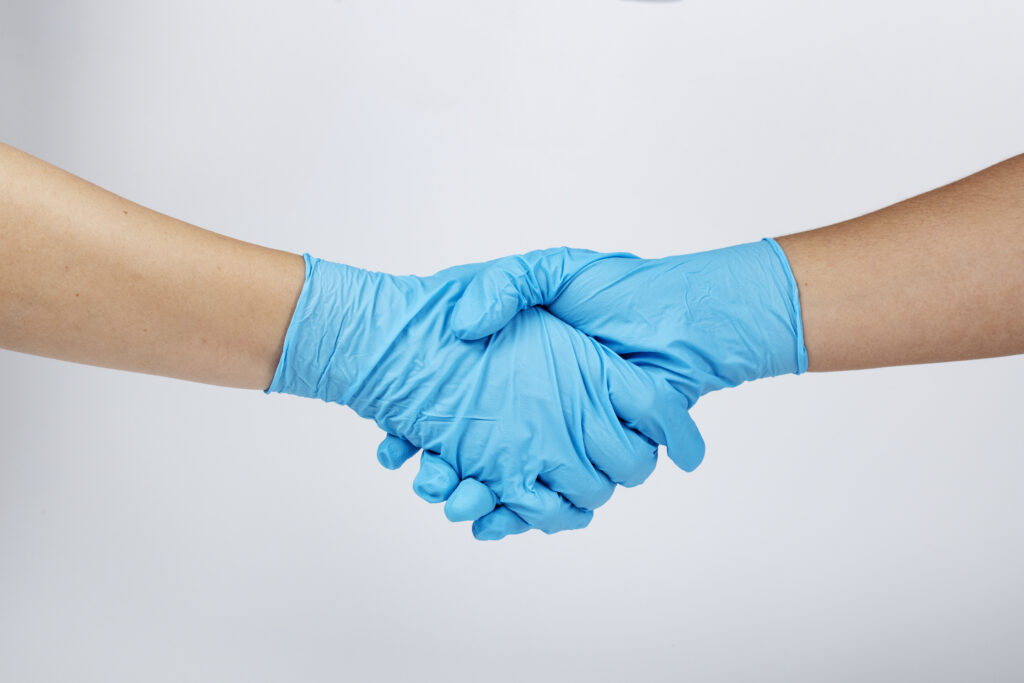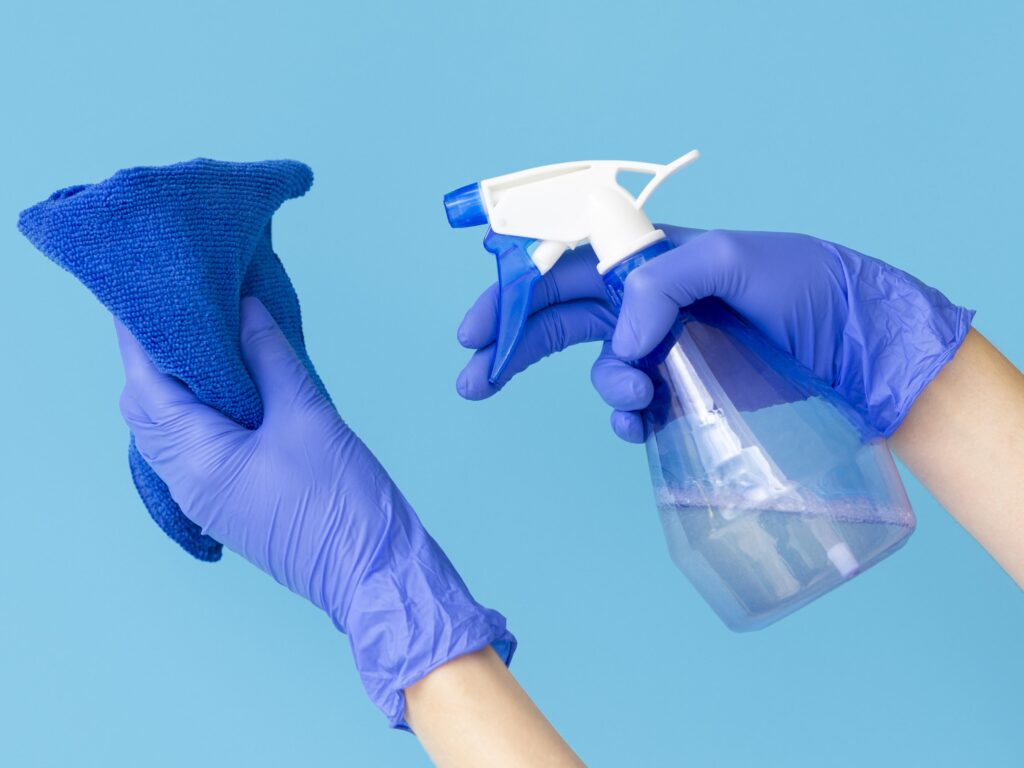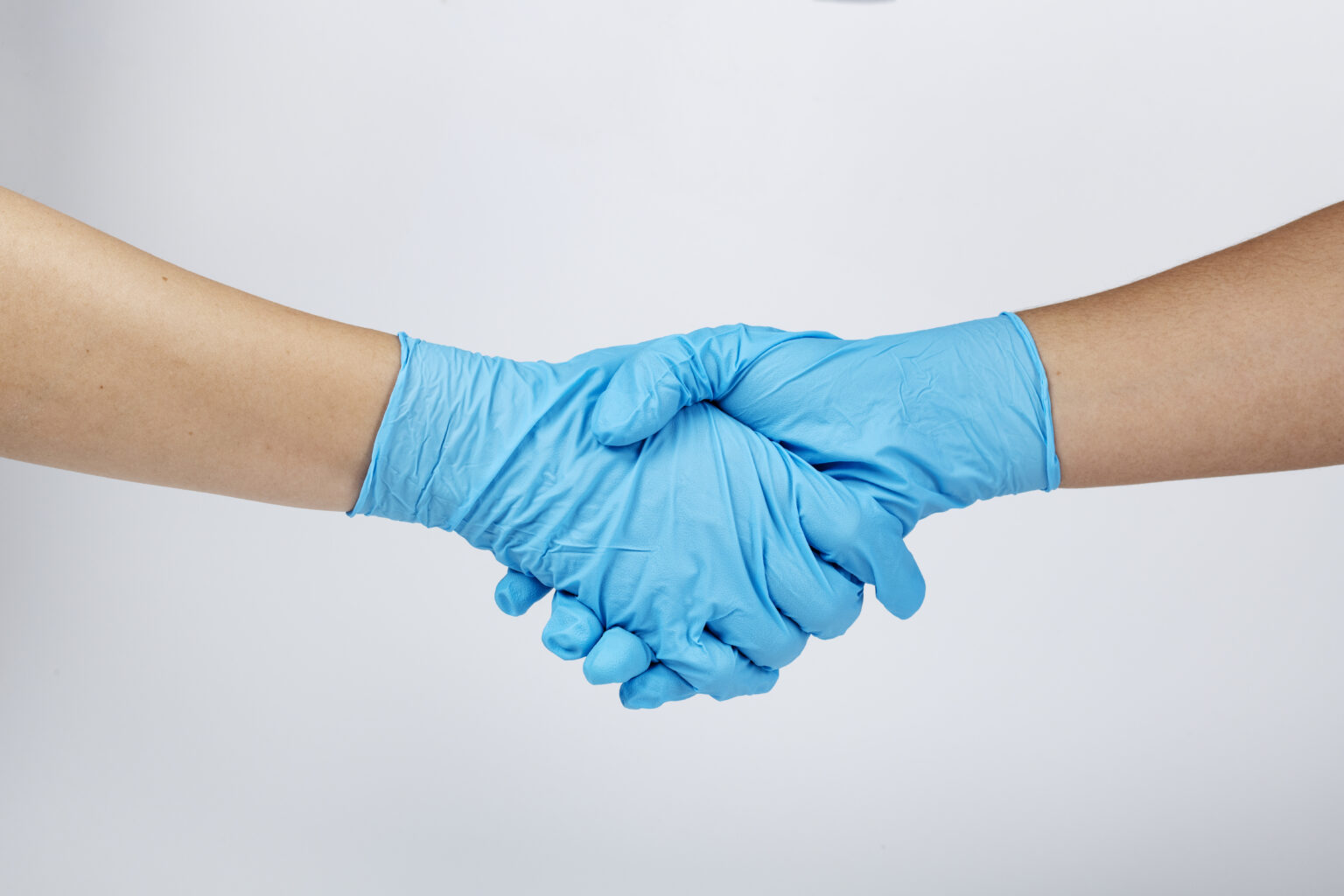Disposable gloves (also known as single use gloves) are meant to protect the wearer’s hands from potential contaminants, chemicals, or to prevent the transfer of germs and bacteria during short-term usage.
Lightweight and versatile, they are made from various materials, including latex, nitrile, vinyl, and polyethylene, each offering different levels of protection, sensitivity, and flexibility.
Disposable gloves are an essential piece of safety equipment in many industries such as healthcare, where they prevent cross-contamination between patients and caregivers, and food service, where they maintain sanitary conditions by preventing direct hand contact with food.
In this article, we will walk you through the main use cases for disposable gloves, the factor to consider before your purchase, and the safety standards for certified gloves in Europe.
Here is a list of everything we will cover:
- Use Cases For Disposable Gloves
- What Different Types of Single Use Gloves Are There?
- 6 Factors To Consider When Choose The Best Disposable Gloves
- European Regulations and Standards For Safety Gloves
- Your FAQ

Use Cases For Disposable Gloves
Disposable gloves are the best PPE solution for a wide range of industries and use cases such as:
- Healthcare: In hospitals, clinics, and dental offices, disposable gloves protect healthcare workers and patients from the spread of infectious diseases. They are used during patient examinations, surgeries, and while handling bodily fluids. For instance, nurses wear gloves when drawing blood or administering injections to prevent the transmission of bloodborne pathogens.
- Laboratory Work: Scientists and lab technicians wear disposable gloves to protect their hands from hazardous chemicals, reagents, and potential biological hazards during experiments and research.
- Food Handling and Preparation: In the food industry, single use gloves are worn to prevent the direct contact of hands with food, thereby reducing the risk of foodborne illnesses. They are a must in settings such as restaurants, cafeterias, and food processing plants, especially when handling raw meat or ready-to-eat foods. Read more on food-grade gloves in our article: Choosing the Right Food Service Gloves
- Cleaning and Janitorial Work: Disposable gloves protect the hands of cleaning staff from harsh cleaning agents, detergents, and potential contact with waste material. They are commonly used in both residential and commercial cleaning to maintain hygiene and prevent skin irritation from cleaning products.
- Beauty, Hair Salons, Tattoo and Piercing Studios: In salons, disposable gloves are used during hair coloring, chemical treatments, and manicures to prevent chemical burns and skin irritation from dyes, bleaches, and other styling products. Artists and piercers wear gloves to prevent cross-contamination and maintain a sterile environment while working on clients, ensuring the safety of both the artist and the client.
- Pharmaceuticals: Workers in pharmaceutical manufacturing and compounding pharmacies use disposable gloves to handle sensitive medications and compounds, guaranteeing that products remain uncontaminated.
- Childcare and Education: Disposable gloves are used in childcare centers and schools during diaper changes, cleaning, and when administering first aid to prevent the spread of germs and infections among children.
What Different Types of Single Use Gloves Are There?
Disposable gloves come in various materials, each offering unique benefits suited to different tasks and environments.
Here are the main types of disposable gloves available on the market:
- Latex Gloves: Latex gloves provide excellent elasticity, comfort, and dexterity, making them suitable for precise tasks. They are commonly used in healthcare settings for procedures requiring precision, such as surgery, as well as in laboratories and food service. However, keep in mind that many people are allergic to latex, or can develop allergies over time.
- Nitrile Gloves: Nitrile gloves are highly resistant to different levels of punctures, as well as certain types of chemicals and oils, making them suitable for handling a good range of hazardous materials. They offer excellent durability and flexibility without the risk of latex allergies. That’s why they are widely used in healthcare, food processing, automotive repair, and janitorial services where superior protection and tactile sensitivity are a must.
- Vinyl Gloves: Vinyl gloves are cost-effective and offer decent barrier protection against certain types of chemicals. They are latex-free, making them suitable for individuals with latex allergies.Vinyl gloves are commonly used in food service, cleaning, and light-duty tasks where durability and tactile sensitivity are less critical but comfort and affordability are prioritized.
- Polyethylene Gloves: Polyethylene gloves are lightweight, cost-effective, and offer basic protection against certain types of contaminants. They are commonly used for short-duration tasks where frequent glove changes are necessary. Polyethylene gloves are often used in food handling, cleaning, and general-purpose applications where a simple barrier is sufficient.
- Neoprene Gloves: Neoprene gloves offer excellent chemical resistance and durability, making them suitable for handling certain types of harsh chemicals and solvents. They provide a higher level of protection compared to latex or vinyl gloves. Neoprene gloves are commonly used in laboratories, industrial settings, and automotive maintenance where protection against chemical exposure is required.
- Polyisoprene Gloves: Polyisoprene gloves offer similar elasticity and comfort to latex gloves without the risk of latex allergies. They provide excellent barrier protection and tactile sensitivity. Polyisoprene gloves are generally preferred in healthcare settings where latex allergies are a concern but high tactile sensitivity and performance are required, such as surgical procedures.

6 Factors To Consider When Choose The Best Disposable Gloves
Selecting the right disposable gloves involves considering several key factors to make sure they meet your specific requirements, such as:
- Material Compatibility: Different materials offer varying levels of protection and suitability for specific tasks. Consider the compatibility of the glove material with the substances you’ll be handling. You can read more about this in our previous article: What’s The Difference Between Nitrile, Vinyl, And Latex Gloves?
- Allergen Sensitivity: Some individuals may have allergies to certain glove materials, such as latex. Choose gloves that are hypoallergenic and safe for all users.
- Durability and Puncture Resistance: Consider the durability and puncture resistance of the gloves, especially for tasks involving sharp objects or rough surfaces. In industries like automotive repair or construction, where workers handle sharp tools and materials, opt for gloves with high puncture resistance, such as nitrile or neoprene gloves, to minimize the risk of injury. For more information on cut resistant gloves, read our article: How To Choose Cut-Resistant Gloves
- Tactile Sensitivity and Dexterity: Tasks requiring precision and fine motor skills demand gloves that offer high tactile sensitivity and dexterity. Surgeons and laboratory technicians rely on gloves with excellent tactile sensitivity, like latex or polyisoprene gloves, to perform delicate procedures accurately.
- Comfort and Fit: Comfortable gloves that fit well can enhance productivity and reduce hand fatigue during extended wear. In food service and healthcare settings, where gloves are worn for long periods, choose gloves with a snug yet comfortable fit to ensure wearer comfort and compliance with safety protocols. You can read more on how to choose the right glove size in our previous article: How To Choose The Right Work Glove Size
- Special Features: Some gloves come with additional features like textured surfaces for improved grip or extended cuffs for added protection. Gloves with textured fingertips are beneficial in environments where a secure grip is important, such as food service or laboratory work, while extended cuff gloves provide extra coverage for tasks involving exposure to liquids or chemicals.

European Regulations and Standards For Safety Gloves
In Europe, safety gloves are subject to stringent regulations and standards to ensure their effectiveness in protecting users against various hazards.
Here are the key European standards for safety disposable gloves:
- EN 420: The EN 420 standard sets general requirements for protective gloves regarding design, construction, comfort, and fit. It guarantees that safety gloves provide adequate protection without compromising wearer comfort and dexterity. All safety gloves sold in Europe must meet the requirements outlined in EN 420.
- EN 388: The EN 388 standard specifies the performance requirements for gloves intended to protect against mechanical risks, such as abrasion, blade cuts, tearing, and punctures. It assigns a numerical rating to each hazard, allowing users to assess the level of protection provided by the gloves.
- EN 511: The EN 511 standard applies to gloves designed for protection against cold environments. It assesses the glove’s insulation properties and resistance to convective and contact cold, as well as water permeability. EN 511-compliant gloves are commonly used in industries where workers are exposed to cold temperatures, such as freezer storage facilities, cold storage warehouses, and outdoor construction sites during winter months.
- EN 407: The EN 407 standard addresses gloves’ resistance to thermal hazards, including heat, flame, and contact with molten metals. It provides a standardized method for evaluating gloves’ performance in high-temperature environments. Gloves undergo testing for parameters such as resistance to flammability, contact heat, convective heat, radiant heat, small splashes of molten metal, and large splashes of molten metal. EN 407-certified gloves are a must for workers in industries where heat and flame hazards are prevalent, such as welding, foundries, glass manufacturing, and metal fabrication.
Your FAQ
- Can I use my disposable gloves more than once? No, disposable gloves are designed for single-use only. Reusing disposable gloves can compromise their integrity and increase the risk of cross-contamination. After each use, single use gloves should be discarded safely and replaced with a new pair.
- Can I clean my disposable gloves? No, disposable gloves should not be cleaned or reused. Cleaning disposable gloves can compromise their protective properties and effectiveness. It is important to discard used gloves properly and replace them with fresh ones.
- Are disposable gloves food safe? Disposable gloves intended for food handling are designed to meet strict safety and hygiene standards. Look for gloves that are labeled as “food-safe” to make sure they are suitable for direct contact with food.
- How do I dispose of my disposable gloves? Single use gloves should be disposed of properly to minimize the risk of contamination and environmental impact.
Follow these steps for safe disposal: Remove gloves carefully, avoiding skin contact with the exterior surface. Dispose of used gloves in a designated waste bin or trash receptacle. Avoid touching your face or other surfaces after glove removal. Wash your hands thoroughly with soap and water or use hand sanitizer.

Conclusion
Choosing the right disposable gloves for your use cases is a must for maintaining safety, hygiene, and efficiency in any industry and work environment.
Next, you can browse our full selection of disposable gloves selected from the most trusted manufacturers in Europe or get in touch with our experts for a consultation or a personal quote.

















